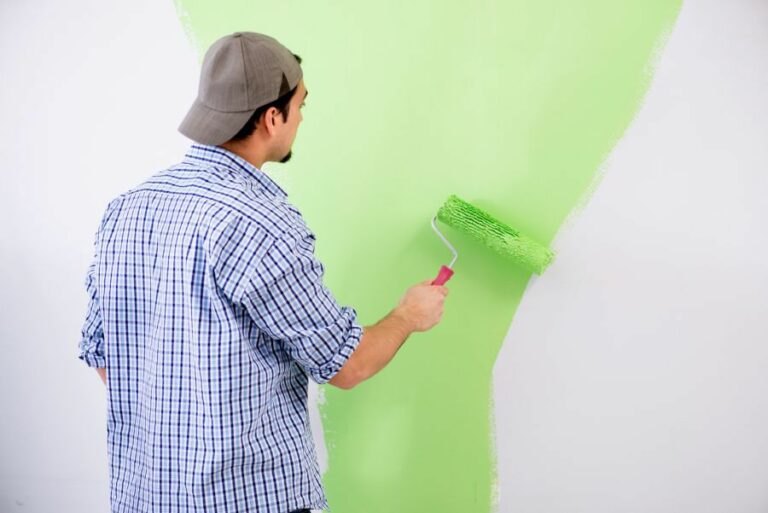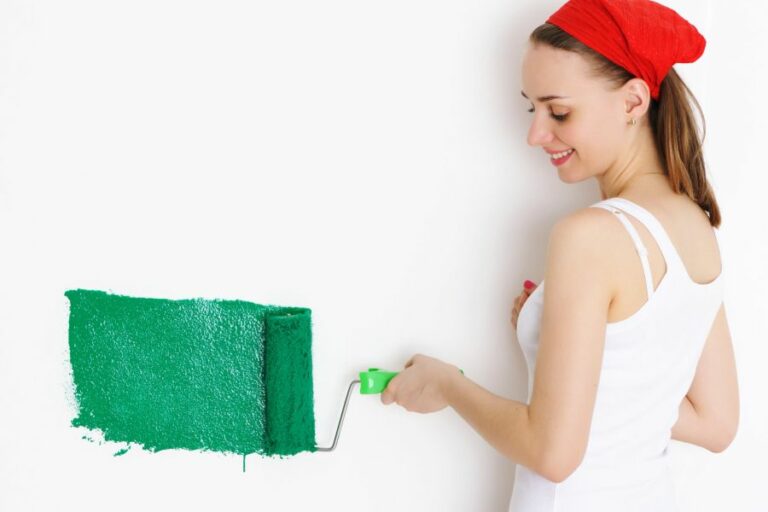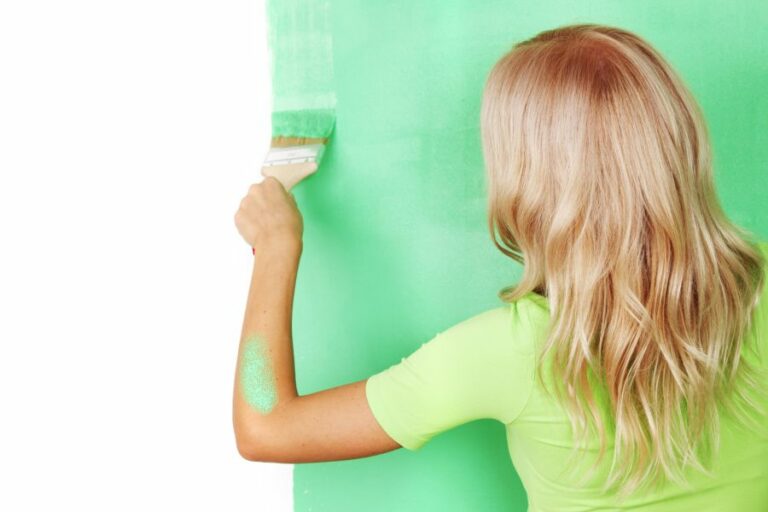Metallic Paint For Interiors, 25 Things You Should Know
Are you looking to add some shine and sparkle to your interiors? Metallic paint can be the perfect solution to transform your space and create a luxurious atmosphere. As an expert in interior design and paint, I can confidently guide you on how to use metallic paint for your interiors.
Metallic paint for interiors:>
Metallic paint is a special type containing metallic particles, typically mica, that adds depth, dimension, and sophistication to interior spaces. Available in various shades and finishes, such as gold, silver, and bronze, it has gained popularity for its affordability and ability to elevate the appearance of any room. Types of metallic paint include water-based, solvent-based, and metallic paint additives. Proper application, layering techniques, and maintenance are essential for achieving professional results and maintaining the paint’s appearance.

Discover the transformative power of metallic paint for interiors! Unleash your creativity and learn how to add a touch of glamour, elegance, and drama to your living spaces. Read on for expert tips and design ideas that will leave you and your guests marveling at the results.
Contents
- 1 Metallic Interior Paint: Enhance Your Space
- 2 Achieve a Stunning Look with Metallic Wall Paint
- 3 Guide to Applying Metallic Paint on Interior Walls
- 4 Exploring the World of Metallic Wall Paint Options
- 5 Steps to Painting Your Room with Metallic Finishes
Metallic Interior Paint: Enhance Your Space
• Introduction to Metallic Paint
Metallic paint is a unique type of paint that adds depth, dimension, and a touch of sophistication to any room. It contains small metallic particles, typically made of mica, which gives the paint a reflective sheen that mimics the look of metal.
Metallic paint is available in various shades and finishes, including gold, silver, bronze, and copper.
In recent years, metallic paint has become increasingly popular for interior design, as it offers an easy and affordable way to elevate the look of any room.
• Choosing the Right Type of Metallic Paint
When it comes to selecting the perfect metallic paint for your interior project, you have several options to choose from. The main types of metallic paint available on the market are:
– Water-Based Metallic Paint
Water-based metallic paint is a popular choice for many do-it-yourself enthusiasts, as it is easy to clean up with soap and water, dries quickly, and has a low odor. This type of paint is also non-toxic and more environmentally friendly than its solvent-based counterparts.
– Solvent-Based Metallic Paint
Solvent-based metallic paint tends to have better adhesion and a higher sheen level, making it ideal for more heavy-duty applications or in high-traffic areas. However, this type of paint has a stronger odor, requires longer drying times, and may be more difficult to clean up.
– Metallic Paint Additives
A third option for achieving a metallic paint finish is by adding metallic powder or liquid additives to standard paint. This method allows you to switch colors, and the level of metallic effect can be customized to suit your needs.
To decide which type of paint is best for your interior project, consider factors such as ease of application, drying time, odor, and the desired level of sheen.
• Application Techniques for Metallic Paint
– Preparing the Surface
A successful metallic paint application starts with proper preparation of the surface. Ensure the area is clean, dry, and free of any traces of old paint, wallpaper, or other debris. A primer is highly recommended for providing a smooth, even surface that enhances the metallic finish.
Select a primer with a tint similar to the metallic paint color for the best results.
– Applying the Metallic Paint
There are various application techniques you can use to achieve different effects with metallic paint. The most common methods are:
Brush
Using a high-quality brush designed for metallic paints can help you achieve a smooth, even finish. Gently apply the paint in “X” motions, overlapping each stroke to minimize visible brush lines.
Roller
A foam or microfiber roller is recommended for applying metallic paint evenly across larger surfaces. Roll the paint in one direction and then cross-roll in the opposite direction for a seamless finish.
Spray
For professional results and hard-to-reach areas, using a paint sprayer can be an excellent option. Ensure you use the appropriate spray tip and pressure settings according to the manufacturer’s instructions.
– Layering Techniques for Metallic Paint
For an even more dramatic effect, metallic paint can be layered with other paint finishes. Techniques such as color washing, glazing, or using metallic paint as an accent on top of a base color can add depth and texture to your space.
One popular layering technique is to create a metallic glaze by combining metallic paint with a clear glazing medium. Apply this glaze over a solid base color, and then use a brush, rag, or sponge to manipulate the glaze, revealing the base color beneath and creating a unique, multidimensional effect.
• Tips for Professional Results
- Always read and follow the manufacturer’s instructions and recommendations on the paint label.
- Test your chosen paint and application technique on a small, inconspicuous area before beginning your project.
- Ensure proper ventilation in the room while working with paint, especially solvent-based products.
- Apply the paint in thin, even coats, allowing adequate drying time between layers.
- Use high-quality brushes, rollers, or sprayers specifically designed for metallic paint application.
- For a consistent finish, mix all your paint in a single container to avoid slight color variations between cans.
• Maintaining Your Metallic Paint Finish
To keep your metallic paint looking stunning for years to come, proper care and maintenance are essential. Regular dusting, wiping with a damp cloth, and avoiding abrasive cleaners will help preserve the finish.
In high-traffic areas or areas prone to moisture, applying a protective clear coat can help extend the life of the metallic paint.
• Conclusion
Incorporating metallic paint into your interior design can provide a stunning and eye-catching touch to any room. By choosing the right type of metallic paint, utilizing proper application techniques, and following expert tips, you can achieve professional results in your own home.
For more information about metallic paint, visit the Paint Quality Institute’s website for valuable resources and guidance.
Achieve a Stunning Look with Metallic Wall Paint
• The Appeal of Metallic Paint
Metallic paint has become a popular choice for those seeking to bring a sense of luxury and sophistication to their interior spaces. The unique reflective properties of metallic paint can create an eye-catching, luminous effect that transforms ordinary walls into stunning works of art.
The variety of metallic hues and finishes available adds to its versatility, making it suitable for a wide range of interior design styles, from modern minimalism to classic elegance.
– Advantages of Metallic Paint
Using metallic paint in interior design offers several advantages. First, it reflects light in a way that adds depth and dimension to a room. With proper lighting, these reflective qualities can create an illusion of space, especially in smaller rooms.
Additionally, the glossiness of the finish can hide minor imperfections in the wall surface, such as small cracks or uneven textures. Finally, metallic paint offers a unique and stylish touch that can elevate the overall aesthetic of a space.
– Choosing the Right Metallic Paint
When selecting metallic paint, it is essential to consider the room’s overall design scheme. Bold metallic colors, like gold or copper, make a strong statement and work well as an accent wall when paired with neutral colors.
Subtle metallic hues, such as silver or light bronze, blend seamlessly into various color schemes and can be used on all walls for a more uniform look. The desired finish, whether it be glossy, matte, or textured, will also impact the final appearance.
• Expert Tips for Applying Metallic Paint
– Proper Surface Preparation
The key to achieving a flawless metallic finish starts with proper surface preparation. Like any paint job, the wall should be cleaned of any dirt or grease and allowed to dry completely.
Filling any cracks and sanding down uneven areas is vital, as the reflective properties of metallic paint will highlight imperfections. After addressing any necessary repairs, apply a high-quality primer to ensure an even color application and optimal paint adhesion.
– Using the Right Tools
High-quality brushes and rollers are essential for achieving a smooth, even application of metallic paint. Brushes with synthetic bristles work best, as they are less likely to leave brush marks. A short nap roller, preferably 1/4-inch, is recommended to minimize roller stipple.
If a more textured finish is desired, consider using specialty tools like metallic paint sponges or sea sponges to create unique patterns and depth.
– Applying the Paint Correctly
When applying metallic paint, it is crucial to maintain a “wet edge” to achieve a consistent finish. This can be done by working in small sections, keeping a dampened brush or roller, and avoiding overlaps.
Make sure to apply a thin, even coat and allow it to dry completely before assessing whether a second coat is necessary.
Using a cross-hatch or crisscross technique when applying the paint can also help eliminate streaks and create a more seamless appearance.
– Adding Protective Finishes
A clear protective topcoat is often necessary to ensure the longevity of metallic paint finishes, especially in high-traffic areas.
A water-based polyurethane sealer works best, as it will not yellow over time. Several brands also offer their metallic paint clear coats, which are specifically formulated to preserve the reflective qualities of the paint.
• A Word of Caution
While metallic paint can transform a room into an elegant and visually captivating space, it is essential to approach this design element with caution. The paint’s reflective properties can amplify natural light, which may produce glare in specific areas of a room.
Therefore, thoughtful consideration of the room’s layout and lighting is imperative. Additionally, metallic paint can be less forgiving and may require a more skilled hand or professional painter to achieve a flawless result.
• In Conclusion
Metallic paint can undoubtedly elevate the look of a space, adding depth, sophistication, and a touch of luxury. With proper preparation, quality tools, and skillful application, homeowners can achieve stunning results that will leave a lasting impression.
From subtle silvers to bold golds, metallic paint brings a unique and timeless quality that can transform ordinary walls into stylish design statements.
Guide to Applying Metallic Paint on Interior Walls
A fresh coat of paint can dramatically change the ambiance of any room, and using metallic paint adds an extra layer of sophistication and elegance. Metallic paint reflects light and provides depth, creating an eye-catching focal point.
• Step 1: Choose the Right Metallic Paint
There are a variety of metallic paint brands and finishes available. Some are highly reflective, while others have a more subtle shimmer. Pick a color and finish that complements your existing decor and personal tastes.
High-quality paint products can make a significant difference in the final look, so don’t be afraid to spend a little extra for a reputable brand.
• Step 2: Gather Your Supplies
Having the right tools will make your painting project smooth and efficient. Here is a list of essential supplies:
- Metallic paint of your choice
- Primer
- Roller with a dense foam or low-nap cover
- High-quality paintbrush
- Paint tray
- Drop cloth
- Painter’s tape
- Sandpaper (180 to 220 grit)
- Clean cloth or tack cloth
• Step 3: Prepare the Surface
To achieve a smooth and even finish, it is crucial first to prepare the walls:
- Clean the walls: Remove dust, dirt, and grease by wiping them down with a damp cloth. Allow the surface to dry thoroughly before proceeding.
- Repair any damage: Fill in any cracks or holes with a patching compound or wall putty. Once dry, lightly sand the area to create a smooth surface. Wipe away any dust with a clean cloth.
- Sand the walls: Lightly sand the entire wall with medium-grit sandpaper to create an even and slightly rough surface to the primer and paint to adhere.
- Protect adjacent surfaces: Use painter’s tape to protect baseboards, moldings, and trim. Place a drop cloth down to protect your floors.
• Step 4: Prime the Walls
A primer is necessary when painting with metallic paint because it provides an even base for the paint, hides surface imperfections, and helps avoid streaking or uneven color. Choose a primer formulated for metallic paint or one that matches the base coat color.
- Apply the primer: Following the manufacturer’s instructions, use a roller for large areas and a brush for smaller areas and edges. Apply a thin, even coat, moving in one direction.
- Allow to dry: Wait for the recommended drying time stated on the primer label.
- Inspect and sand, if necessary: If the primer coat reveals any remaining imperfections, lightly sand again using fine-grit sandpaper. Wipe the surface with a clean cloth to remove any dust.
• Step 5: Apply the Metallic Paint
Now it’s time to add the glamorous metallic finish to your walls.
- Mix the paint well: Stir the paint thoroughly to ensure an even distribution of the metallic particles.
- Apply the first coat: Starting in an inconspicuous area, use a roller or brush to apply a thin, even coat of metallic paint. Work in small sections and maintain a wet edge to avoid visible seams or breaks. Overlapping brush strokes can create a textured effect that enhances the metallic sheen.
- Allow to dry: Allow the first coat to dry for the recommended time stated on the paint label.
- Apply additional coats: Depending on the opacity and the look desired, you may need two or more coats of metallic paint. Be sure to let each coat dry before applying the next one.
- Inspect the final finish: Once the final coat is dry, check for uniform coverage and touch up any areas if necessary.
• Step 6: Clean Up and Enjoy
Remove the painter’s tape once the paint is dry, being careful not to damage the paint’s edges. Dispose of used rollers, brushes, and paint trays properly. Finally, take a step back and admire your beautiful new metallic walls.
By following these steps, you can enjoy a professional-looking metallic finish that adds style and sophistication to your home’s interior. Allow yourself to explore various metallic paint colors and finishes to create a truly unique space.
Exploring the World of Metallic Wall Paint Options
Absolutely! Metallic wall paint is an innovative and eye-catching option for those seeking to give their home interior or exterior a unique and shimmering appearance. From silvery tones to rich copper, metallic paints offer a range of eye-catching colors to suit any design aesthetic.
• What is Metallic Wall Paint?
Metallic wall paint is a specially formulated paint that contains metal or metal-like particles suspended in a paint base to create an appealing decorative finish. These particles catch light and reflect it, resulting in a shimmering, multi-toned appearance reminiscent of metal surfaces.
– Different Types of Metallic Wall Paints
There are several metallic paint types available, varying in the size of metallic particles, sheen level, and formulation. Here are some common types:
Metallic Acrylic Paints
A water-based and low-VOC (Volatile Organic Compounds) option, metallic acrylic paints are an environmentally friendly choice, offering quick drying and easy cleanup with soap and water. These paints are suitable for both interior and exterior applications.
Alkyd Metallic Paints
Alkyd-based metallic paints are oil-based and offer a denser and more lustrous finish. However, they often have a strong odor and require a longer drying time. These paints are recommended for interior surfaces, as they may not withstand harsh outdoor conditions.
Hybrid Metallic Paints
These paints combine the best of both worlds by incorporating both alkyd and acrylic resins. They offer the durability and sheen of alkyd-based paints while maintaining the ease of use and low odor of acrylic paints.
• Benefits of Metallic Wall Paint
Metallic wall paint offers numerous benefits, some of which include:
– Unique Aesthetics
A metallic finish can add elegance, warmth, and texture to any room, creating a striking visual effect that sets your space apart from the ordinary. It can also provide a beautiful backdrop for artwork, furniture, and accessories.
– Durability
Since metallic paint is specifically designed for wall and surface application, it typically boasts increased durability and resistance to wear and tear compared to conventional paint.
– Light Reflection
The reflective properties of metallic paint can help brighten spaces and create an illusion of a larger area, making it an excellent choice for small or dimly lit rooms.
• Application Tips for Metallic Wall Paint
– Surface Preparation
As with any paint job, proper surface preparation is essential for a successful metallic paint application. Clean the surface of dirt, dust, and grease, then repair any cracks, holes, or damaged areas. Sand the surface until it is smooth, and apply a quality primer to enhance paint adhesion and coverage.
– Paint Selection
Choose a metallic paint suitable for the specific application (i.e., interior or exterior) and desired sheen level. For those new to metallic paint applications, opt for a water-based, low-sheen paint, which is more forgiving and easier to work with.
– Use the Right Tools
For a professional-looking finish, invest in high-quality brushes and rollers. A soft synthetic paintbrush is ideal for cutting in around corners and edges, while a low-nap roller will provide an even coverage without leaving streaks or roller marks.
– Apply Multiple Thin Coats
To achieve the desired metallic effect, apply several thin layers rather than one thick coat. This will help avoid drips, runs, and an uneven finish. Allow each coat to dry thoroughly before applying the next.
– Finishing Touches
Once the final coat is dry, assess whether or not a protective topcoat is required. A clear, non-yellowing topcoat can help protect the metallic finish from scratches, scuffs, and fading.
In conclusion, metallic wall paint is a fantastic option for those seeking to add depth, warmth, and a touch of glamour to their space. With proper surface preparation, paint selection, and application techniques, a stunning metallic finish is achievable for any DIY enthusiast.
For further information and advice, consult resources provided by paint manufacturers and industry experts to ensure your project’s success.
Steps to Painting Your Room with Metallic Finishes
Painting a room with metallic paint can seem intimidating, but with careful planning and preparation, you can achieve stunning results. Metallic paint adds depth, sophistication, and a touch of glamour to any space.
• Choosing the Right Metallic Paint
When selecting metallic paint for your room, consider the overall color scheme and design. Metallic paint works best as an accent, so choose a color that complements the existing hues in your room.
There are various types of metallic paint available in the market, including acrylic-based metallic paint, metallic latex paint, and metallic enamel paint. Each type has its pros and cons, but all offer a shimmering finish that adds visual interest to your space.
• Gathering the Necessary Supplies
Before beginning any painting project, it’s essential to gather all the required materials. For painting with metallic paint, you will need the following items:
- Metallic paint
- Primer (specifically designed for metallic paint)
- Paint roller
- Paint tray
- Paintbrush (preferably with synthetic bristles)
- Painter’s tape
- Drop cloths or plastic sheeting
- Ladder
• Preparing the Surface for Painting
To ensure your metallic paint adheres properly and looks its best, thorough surface preparation is crucial. Follow these steps:
1. Clean the Walls
Remove dirt, dust, and grease from the walls by wiping them down with a damp sponge or cloth. Allow the walls to dry completely before proceeding.
2. Repair any Imperfections
Fill in any cracks, holes, or other imperfections with a patching compound or spackle. Once the compound is dry, sand the area smooth with a fine-grit sandpaper.
3. Apply Primer
Applying a primer specifically designed for metallic paint is essential to achieve an even and vibrant finish. The primer helps create a smooth surface, ensuring better adhesion of the metallic paint. Allow the primer to dry according to the manufacturer’s instructions.
• Painting the Room with Metallic Paint
Once the surface is clean, repaired, and primed, it’s time to begin painting with metallic paint.
1. Apply the Base Coat
Using a paint roller, apply a base coat of metallic paint to the walls. Use a paintbrush to cut in along edges, corners, and other tight spaces. Allow the base coat to dry for the recommended time specified on the paint can.
2. Apply the Metallic Top Coat
Following the instructions on the paint can, mix the metallic paint thoroughly to ensure the metallic particles are evenly distributed throughout the paint.
Use a clean paint roller and tray to apply the metallic top coat, working in small sections and using a crisscross or overlapping pattern to create the desired metallic effect. For a more pronounced metallic finish, use a paintbrush to dab the paint onto the wall, then smooth it out using long, vertical strokes.
3. Touch Up with a Paintbrush
After the metallic top coat is dry, inspect the walls for any areas that need touch-ups. Use a paintbrush with synthetic bristles for more precise work, making sure to blend the brush strokes into the surrounding paint.
• Finishing Touches and Clean Up
Once you have finished painting the room, remove the painter’s tape and dispose of any used drop cloths or plastic sheeting. Clean your brushes, rollers, and paint trays with warm, soapy water to ensure they are ready for future projects.
Allow ample time for the paint to dry before moving furniture back into the room.
• Final Thoughts
Painting a room with metallic paint may require extra time and effort, but the results can be truly transformative. By following these steps and utilizing high-quality materials, you can create a stunning and sophisticated space that showcases your personal style.
Step | Description |
|---|---|
1. Prepare the room | Remove furniture, cover the floor with drop cloths, and tape off any areas that need to be protected from paint. |
2. Clean and prep surfaces | Fill any holes or cracks with filler, sand the surfaces smoothly, and clean the walls with a damp cloth to remove dust. |
3. Apply a primer | Apply a primer suitable for metallic paint and let it dry completely. This will ensure a smooth, even base for the metallic paint to adhere to. |
4. Stir the metallic paint | Stir the metallic paint well, mixing in any settled metallic particles, and continue to stir occasionally during application. |
5. Cut in edges | Using a small brush, cut in the edges and corners of the room with the metallic paint, applying the paint in sections to avoid streaks. |
6. Apply metallic paint with a roller | Use a roller with a low-nap cover to apply the metallic paint in a W or M pattern, filling in the sections and maintaining a wet edge to avoid roller marks. |
7. Apply extra coats if necessary | Allow the paint to dry completely between coats and apply additional coats as necessary to achieve the desired metallic finish. |
8. Clean up and replace furniture | After the paint has fully dried, remove all masking tape and drop cloths, and replace any furniture that was removed. |







